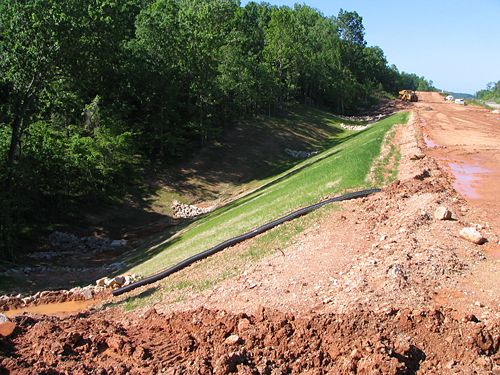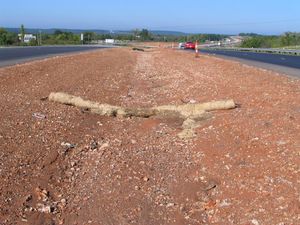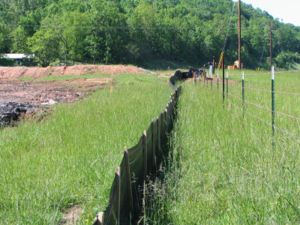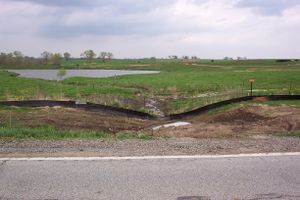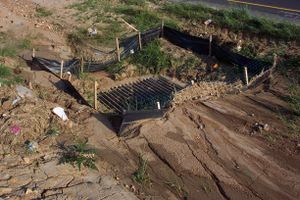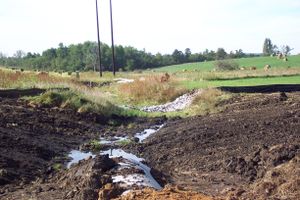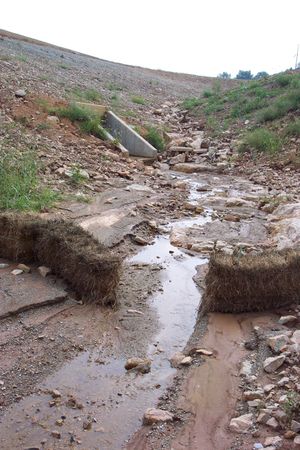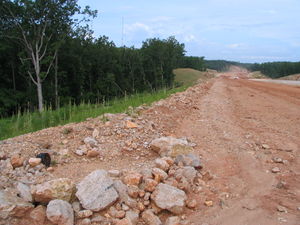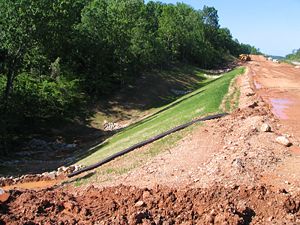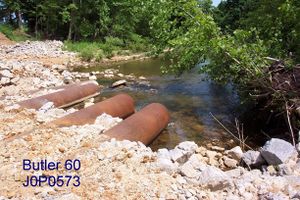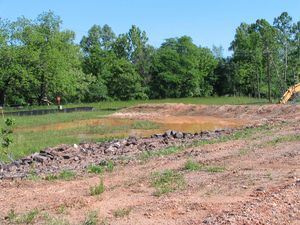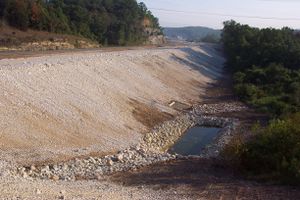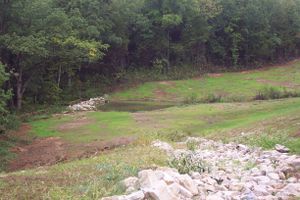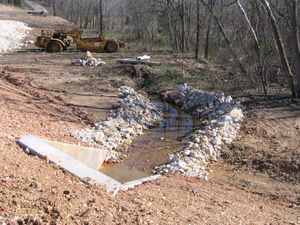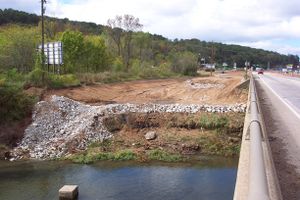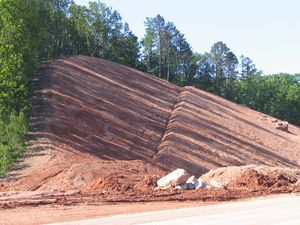Category:806 Pollution, Erosion and Sediment Control
Locally sponsored federal aid projects performed on MoDOT right of way and using MoDOT’s land disturbance permit are required to comply with MoDOT specs and must follow the Storm Water Pollution Prevention Plan (SWPPP).
Contents
- 1 806.1 Introduction (see Sec. 806)
- 2 806.2 Roadway Design Activities
- 3 806.3 Construction Activities
- 4 806.4 Maintenance Activities
- 5 806.5 Traffic Activities (Permits)
- 6 806.6 Materials Activities
- 7 806.7 Construction Inspection Guidance for Sec. 806
- 7.1 Temporary Berms (Sec. 806.10)
- 7.2 Temporary Slope Drains (Sec. 806.20)
- 7.3 Temporary Ditch and Inlet Checks (Sec. 806.30)
- 7.4 Sediment Basin (Sec. 806.40)
- 7.5 Temporary Seeding and Mulching (Sec. 806.50)
- 7.6 Blank (Sec 806.60)
- 7.7 Silt Fence (Sec. 806.70)
- 7.8 Temporary Pipe (Sec. 806.80)
- 7.9 Temporary Erosion Control Blankets (Sec. 806.90)
- 7.10 Temporary Stream Crossing (Sec. 806.100)
- 7.11 806.7.1 Temporary Erosion Control
- 7.12 806.7.2 Contractor’s Erosion Control Plan
- 7.13 806.7.3 Best Management Practices (BMP)
- 7.14 806.7.4 Maintenance During Construction
- 7.15 806.7.5 Permanent Erosion Control
- 7.16 806.7.6 Basis of Payment
- 7.17 806.7.7 Contractor Performance
806.1 Introduction (see Sec. 806)
Providing for the control of both sheet and gully erosion is a necessary part of any highway project. This article and EPG 611 Embankment Protection are concerned with methods and criteria for the control of sediments from sheet erosion during and after construction activites. Control of gully erosion in roadside channels and at culvert outlets is discussed in EPG 750.6 Erosion Control and Energy Dissipation.
Provisions of the federal clean water act and related state rules and regulations require stormwater permits where construction activities disturb greater than one acre over the life of a project as part of a common plan or sale. MoDOT has a general permit, obtained from the Missouri Department of Natural Resources (MDNR), which allows MoDOT to accomplish road construction activities. This permit may be found on MDNR's website at http://www.dnr.mo.gov/env/wpp/permits/issued/R100000.pdf. It requires MoDOT develop and adhere to a Storm Water Pollution Prevention Plan (SWPPP). It also stipulates that MoDOT will follow certain erosion control guidelines and install temporary erosion control measures. This permit applies only to land disturbance activities associated with MoDOT on MoDOT right of way. Locally sponsored federal aid projects will need to obtain similar appropriate permits.
806.2 Roadway Design Activities
Contract plans shall include erosion control measures that are sufficient to protect streams, lakes and private land adjacent to MoDOT right of way.
Temporary and permanent water pollution control measures shall be included in design plans such that contractors can develop appropriate bids. Control of water pollution will be accomplished through the use of berms, slope drains, ditch checks, sediment basins, seeding and mulching, straw bales, silt fences, and other erosion control devices or methods.
806.2.1 Temporary Measures
Temporary erosion control measures shall be coordinated with permanent erosion control measures to assure economical, effective and continuous erosion control.
Ditch Checks
There are two types of ditch checks that can be used – Type I and Type II. Type I ditch checks include, but not limited to, silt fence, straw bale, wattle logs, and Dura Check Sediment Control Panel®. Type II ditch checks include, but are not limited to, rock, sand bag, and Triangular Silt Dike® (see Section 806.10 of the Missouri Standard Specification For Highway Construction).
Type I ditch checks are specified where drainage areas are 3 acres or less, ditch slopes are 10 percent or less and expected ditch flow volumes are small. Type II ditch checks are specified where drainage areas are 50 acres or less, ditch slopes are 10 percent or less and expected ditch flow volumes are high, or in locations where the project is in close proximity to streams or other sensitive areas. For scenarios that exceed the criteria established above, a combination of Type II ditch checks and erosion control blankets are utilized.
Experience and history have shown that Type II ditch checks perform much better than Type I ditch checks and seldom need to be replaced. For this reason a system of Type II ditch checks, although more expensive than Type I at installation, will often prove to be the less expensive over the life of the project considering the cost of unpredictable storm damage to Type I devices.
Standard Plan 806.10 (Sheet 3 of 7) shows the spacing for ditch checks. An estimate of the required number of ditch checks based on a height of 24 in. should best accommodate the range of typical heights of installed ditch checks.
Silt Fence
Use of a silt fence consists of furnishing, installing, maintaining, and removing a geotextile barrier fence designed to remove suspended particles from water passing through the fence. Materials used for silt fences must meet certain requirements.
Silt fencing is most effective to control sheet erosion along the edge of the right of way where runoff from erodible fill attempts to leave the project onto the adjacent property or into an adjacent stream. Silt fence is never used to cross a ditch, stream or drainage channel, and in no case installed perpendicular to, or downgrade from a pipe or culvert. Likewise, silt fence is never used to protect drop inlets. When drainages are encountered, a perimeter silt fence must be replaced or bolstered by a rock ditch check in the drainage channel.
Straw Bales
Bales of straw can be used as a means of controlling pollution and erosion. The straw bales obstruct the flow of water allowing deposition of sediment and/or diversion of water. Other foliage may be substituted for straw in accordance with Section 802.2.1 of the Missouri Standard Specification For Highway Construction.
This method is typically used at the bottom of embankment slopes to divert runoff from sheet flow and trap sediment, as a ditch check in small ditches and drainage areas, and on the lower side of the cleared areas to catch sediment from sheet flow. When used to trap sediment or divert runoff, the bales must be braced from behind. When used as a ditch check, embedment is required. Straw bales are most effective in areas where there is overland flow (runoff that flows over the surface of the ground as a thin, even layer). They are not effective in areas where there is a large volume of runoff.
Temporary Berms
A temporary berm is a temporary ridge of compacted soil, with or without a shallow ditch, constructed at the top of fill slopes or transverse to centerline on fills. The purpose of these ridges is to divert storm runoff from small areas away from steep slopes and direct this water to temporary outlets where the water can be discharged with minimum slope erosion. These ridges are used temporarily at the top of newly constructed slopes to prevent excessive erosion until permanent controls are installed and/or slopes are stabilized. They are also used transverse to grade to divert runoff to stabilized slope drains. Since temporary berms are usually installed as earth work is underway, and there is no way to predict the amount of work that might be accomplished during the course of a days work, temporary berms will not usually appear on contract plans.
Temporary Slope Drains
A temporary slope drain is used to carry water down slopes to reduce erosion and
consists of stone, concrete or asphalt gutters, half-round pipe, metal pipe, plastic pipe, or flexible rubber pipe. Temporary slope drains are required on fill slopes at approximately 500-foot intervals or as directed by the engineer.
Temporary Seeding and Mulching
This work shall consist of preparing and fertilizing a seedbed, furnishing and sowing of seed, and mulching. The purpose of temporary seeding and mulching is to produce a quick ground cover to reduce erosion in disturbed areas that are expected to be redisturbed at a later date. If the project is to be done in stages and it is known that areas will be shut down for a significant amount of time, designers are to include this cost such that contractors can bid accordingly. MoDOT does not pay for temporary seed or mulch that is used to establish ground cover that is solely established to allow the contractor to disturb additional ground beyond those restrictions in Section 806.50 of the Missouri Standard Specification For Highway Construction.
Temporary Pipe
A temporary pipe is a conduit used temporarily to carry water under a haul road, silt fence, etc. It is used to convey normal and expected high flows at temporary stream crossings, preventing the contractor's equipment from coming in direct contact with the water when crossing active streams or intermittent streams created during heavy rainfalls. All temporary pipe shall be installed in the same manner as permanent pipe is installed on the project to assure that the water does not cause erosion around the pipe. Material to backfill the pipe is placed in six-inch lifts and mechanically compacted, although a compaction test is not required.
Temporary Sediment Basin
A temporary sediment basin is an excavated or dammed storage area that is used for short-term erosion control purposes. These structures should be installed prior to land distrubance activities. They will be constructed with available grading equipment at locations shown on the contract plans. They are commonly used prior to the installation of more permanent, designed erosion controls. In some cases a “temporary” sediment basin can be placed in a location that enables it to continue to be used as a “permanent” sediment and drainage control basin.
Each basin will be of sufficient size to contain a volume of at least 3600 cubic feet per each acre of disturbed area that drains into the basin. Accumulated sediment shall be removed from the basin as needed to ensure the minimum volume of 3600 cubic feet is maintained. Discharges from the sediment basin shall not cause scouring of the banks or bottom of the receiving stream.
Where the use of a sediment basin of sufficient size as described above is impractical, other similarly effective BMP’s, such as a sediment trap, must be employed to prevent sediment from leaving MoDOT right of way.
Sediment Trap
The location of sediment traps will be shown on the plans. A sediment trap is a structure constructed of rock or other non-earthen material sufficient to impound water. It is placed down grade of a drainage structure outlet to prevent sediment from leaving MoDOT right of way. In larger, more permanent streams, they will be placed parallel to the stream at each drainage ditch outlet. They will be in place prior to clearing and grubbing operations and shall remain in place until slopes are seeded and mulched or rock lining for culvert outlets has been placed.
A sediment trap will be constructed in accordance with Standard Plan 806.10 and Standard Specification 806.60. Estimated quantities for each trap located on the project will be shown to the nearest cubic yard.
Sediment Removal
Quantities for sediment removal are estimated using 1 yd3 per ditch check, 1 yd3 per 100 linear ft. of silt fence or straw bale barrier and 10 yd3 per sediment basin.
Road Closure
The temporary closing of a road is not necessarily an erosion control practice; however, the total elimination of local vehicular traffic driving through bridge replacement project provides the maximum availability of all Best Management Practices (BMPs) for erosion control. Closing the road reduces the amount of land disturbance and oftentimes will result in a total disturbed area of less than one acre, the threshold that triggers the mandatory installation of erosion controls regardless of threats to water quality. Road closure usually negates the need for a temporary bypass. Design teams should consider the benefits that result from this BMP flexibility, as well as reduced land disturbance, when road closure is evaluated in the early project stages.
806.2.2 Permanent Measures
Sediment Basins
A sediment basin is a water storage area with rock riprap placed in inlet and outlet areas with defined side slopes
. Sediment basins are constructed to trap and store sediment from erodible areas in order to protect properties and stream channels below the installation from excessive siltation. These structures trap and store sediment that may not be caught by upgrade temporary erosion control measures. If right of way is available, a well-placed sediment basin can negate the need for other temporary controls in the drainage area upgrade from the sediment basin.
Rock Dams
A rock dam is an oversized Type II rock ditch check that serves to impound water and sediment.
It is usually is installed down grade from a culvert outlet or at locations where drainages exit MoDOT right of way. The size (length and height) of the rock dam depends on the volume of water that flows through the drainage structure, and the width of the drainage channel. Rock dams are not appropriate where impounded sediment and gravel could accumulate inside of the culvert. Also, rock dams are not appropriate in streams that are regulated by the US Army Corps of Engineers
under Section 404 of the Clean Water Act. In these cases, rock dams are to be placed at the ditch outlets, parallel to the stream . As with sediment basins, if right of way is available, a well-placed rock dam can negate the need for other temporary controls in the drainage area upgrade from the structure.
Type C Berms
Type C berms are specified at the toes of spill slopes around bridge construction operations and will be constructed to the specified dimension. It is important that the contract plans show the general presence of a type C berm so contractors may bid accordingly. However, the actual precise location of the structure can only be determined at the time of installation and shall be field fit at the direction of the engineer.
Permanent Diversions
On large, steep back slopes permanent diversion berms or terraces are used
transverse to grade to divert runoff to stabilized slope drains. Such diversions will enable the establishment of permanent vegetative cover and will reduce the likelihood of gully formation.
806.3 Construction Activities
806.3.1 Temporary Measures
Temporary erosion control measures shall be coordinated with permanent erosion control measures to assure economical, effective and continuous erosion control. Temporary erosion controls must be kept in place and maintained until revegetation has occurred to an extent sufficient to prohibit the formation of gullies by runoff. The engineer shall routinely inspect the condition of erosion controls and shall notify the contractor immediately if any controls are found to be in disrepair or are not functioning at the desired level of effectiveness. Inspection records and directives to the contractor shall be noted in the inspector's diary, which shall be available for review by MDNR upon request.
Ditch Checks
Type I and II ditch checks shall be placed and constructed according to the contract plans. They shall be checked for sediment accumulation after each significant rainfall. Sediment shall be removed when it reaches one-half of the original height of the check or sooner. Sediment removal will include removal and disposition in a location where it will not erode into construction areas or watercourses. Regular inspections shall be made to ensure that the center of the check is lower than the edges. Erosion caused by high flows around the edges of the ditch check shall be corrected immediately.
Silt Fence
There are several construction requirements for silt fences. Fence construction shall be adequate to handle the stress from hydraulic and sediment loading. Geotextile at the bottom of the fence shall be buried. The trench shall be backfilled and the soil compacted over the geotextile. The geotextile shall be spliced together as indicated on the standard drawings (see Standard Plan 806.10).
Post spacing shall not exceed 8 feet for wire support fence installations or 5 feet for self-supported installations. Posts shall be driven a minimum of 24 inches into the ground. Where rock is encountered, posts shall be installed in a manner approved by the engineer. Closer spacing, greater embedment depth and/or wider posts shall be used as necessary in low areas and soft or swampy ground to ensure adequate resistance to applied loads.
When support fence is used, the mesh shall be fastened securely to the up-slope side of the post. The mesh shall extend into the trench a minimum of 2 inches and extend a maximum of 36 inches above the original ground surface. When self-supported fence is used, the geotextile shall be securely fastened to fence posts.
The integrity of silt fences must be maintained for as long as they are necessary to contain sediment runoff. All silt fences shall be inspected immediately after each rainfall and at least daily during prolonged rainfall. Any deficiencies shall be immediately corrected. In addition, a daily review of the location of silt fences is made in areas where construction activities have changed the natural contour and drainage runoff to ensure that the silt fences are properly located for effectiveness. Where deficiencies exist, additional silt fences shall be installed as approved or directed by the engineer.
Sediment deposits shall be removed and disposed of when the deposit approaches one-half the height of the fence or sooner. If required by heavy sediment loading, a second silt fence shall be installed as directed by the engineer.
The silt fence shall remain in place until the engineer directs that it be removed. Upon removal, the contractor shall remove and dispose of any excess silt accumulations, grade and dress the area to the satisfaction of the engineer, and establish vegetation on all bare areas.
At the time of installation silt fencing is installed in permanent grass, outside of the clearing limits so that a buffer of undisturbed soil remains on both sides of the fence. Perimeter silt fence is not installed across a drainage ditch, stream or water channel.
Straw Bales
The integrity of straw bales must be maintained for as long as they are necessary to contain sediment runoff. All straw bales shall be inspected immediately after each rainfall and at least daily during prolonged rainfall. Any deficiencies shall be immediately corrected. In addition, a daily review of the location of straw bales is made in areas where construction activities have changed the natural contour and drainage runoff to ensure that the straw bales are properly located for effectiveness. Where deficiencies exist, additional straw bales shall be installed as approved or directed by the engineer.
Sediment deposits shall be removed and disposed of when the deposit approaches one-half the height of the bale or sooner. If required by heavy sediment loading, a second set of straw bales shall be installed as directed by the engineer.
The straw bales shall remain in place until the engineer directs that they be removed. Upon removal, the contractor shall remove and dispose of any excess silt accumulations, grade and dress the area to the satisfaction of the engineer, and establish vegetation on all bare areas.
Temporary Berms
Type A Berms are specified for use at the end of each day’s operations on embankments, will be constructed to specified dimensions (see Standard Plan 806.10) and will be machine compacted with a minimum of one pass over the entire width of the berm with a dozer tread, grader wheel, etc.
Type B Berms are specified when embankment operations are shut down over extended periods of time (i.e., winter), will be constructed to specified dimensions (see Standard Plan 806.10) and will be machine compacted with a minimum of three passes over the entire width of the berm with a dozer tread, grader wheel, etc. Temporary Type B berms must drain to a compacted outlet at a slope drain. The top width of these berms may be wider and the side slopes flatter on transverse berms to allow equipment to pass over these berms with minimal disruption.
Temporary Slope Drains
All temporary slope drains will be adequately anchored to the slope to prevent disruption by the force of the water flowing in these drains. The inlet end will be properly constructed to channel water into the temporary drain. The outlet ends will have some means of dissipating the energy of the water to reduce erosion downstream. Unless otherwise specified, all temporary slope drains will be removed when no longer necessary and the site will be restored to match the surroundings.
Temporary Seeding and Mulching
Seeding and/or mulching will be a continuous operation on all cut and fill slopes, waste sites, and borrow pits during the construction process. All disturbed areas shall be seeded and mulched when and where necessary to eliminate erosion. Seeding and/or mulching shall be done as soon as possible after completion of the earthwork, not to exceed 14 days, weather permitting.
Temporary mulch placed over temporary seed mixtures shall be applied in accordance with the provisions of Section 802.2.1 of the Missouri Standard Specifications For Highway Construction. Fertilizer shall be applied at the rate specified for permanent seeding. Lime will usually not be required for temporary seeding but will be applied according to governing specifications when a permanent seed mixture is used.
Permanent seeding and mulching following the temporary seeding will be performed according to Sections 805 and 802, respectively of the Missouri Standard Specification For Highway Construction and will only be permitted during the favorable seeding seasons.
Temporary Pipe
A temporary pipe is a conduit used temporarily to carry water under a haul road, silt fence, etc. It is used to convey normal and expected high flows at temporary stream crossings, preventing the contractor's equipment from coming in direct contact with the water when crossing active streams or intermittent streams created during heavy rainfalls. All temporary pipe shall be installed in the same manner as permanent pipe is installed on the project to assure that the water does not cause erosion around the pipe. Material to backfill the pipe is placed in six-inch lifts and mechanically compacted, although a compaction test is not required.
Additional Temporary Erosion Controls
- Surface Roughening
Surface roughening is a temporary erosion control best management practice that is intended to aid in the establishment of vegetative cover with seed, to reduce runoff velocity and increase infiltration, and to reduce erosion and provide for sediment trapping. This practice is intended for areas which have been cleared and grubbed and are awaiting application of temporary or permanent seed, or installation of other structural controls such as ditch checks, rock dams, or sediment basins. The practice is not intended to serve as a stand-alone best management practice and is only to be used as a short-term (2-3 weeks), sequential practice as the grading and seeding proceeds.
- Mulching and Crimping
Application of mulch without seed may be used as a temporary best management practice if approved by the engineer. This practice is most applicable in late fall or early winter when grass seed would have little or no opportunity to germinate. Straw mulch is applied with a mulch blower or by hand and must be anchored (crimped) immediately after spreading to prevent wind blow. Application rates will vary based on the percent slope.
- Brush Piles
Brush piles are considered to be a temporary BMP that is effective during clearing and grubbing operations. Tree tops, limbs, stumps and other vegetation, when placed in a drainage swale, can effectively impound gravel, soil and other eroded materials that otherwise may be carried off of MoDOT right of way during runoff periods. To be effective, brush piles are usually compressed by clearing equipment at the time of installation. Like other BMPs, brush piles are inspected following heavy rains to ensure that they are functioning as intended. If the brush pile is intended to serve as a semi-permanent structure for an extended period of time beyond the clearing and grubbing stage, clean out and maintenance equivalent to that required for Type 1 and Type 2 ditch checks is required.
806.3.2 Permanent Measures
Construction of permanent erosion control measures that may contribute to the control of siltation, shall be accomplished at the earliest practicable time. This work shall consist of furnishing, installing, maintaining, and removing temporary control measures as shown on the plans or as ordered by the engineer. Berms, slope drains, ditch checks, sediment basins, seeding and mulching, straw bales, silt fences, and other erosion control devices or methods shall be installed so as to ensure that erosion does not move soil particles off of MoDOT right of way. No work shall be started until the erosion control timetable and methods of operation have been approved.
Rock Dams
A rock dam is an oversized Type II rock ditch check that is installed down grade from a culvert outlet. The size (length and height) of the rock dam depends on the volume of water that flows through the drainage structure, and the width of the drainage channel. Rock dams are not appropriate where impounded sediment and gravel could accumulate inside of the culvert. Also, rock dams are not appropriate in streams that are regulated by the US Army Corps of Engineers under Section 404 of the Clean Water Act.
Sediment Basin
The area where a sediment basin is to be constructed shall be cleared of vegetation to enable removal of sediment. The inlets of these sediment basins shall be constructed with a wide cross section and minimum grade to prevent turbulence and allow deposition of the soil particles. When the depth of sediment reaches 1/3 of the depth of the structure in any part of the pool, all accumulation shall be removed. Discharges from the basin shall not cause scouring of the receiving area.
Sediment basins shall normally remain in service until all disturbed areas draining into the structure have been satisfactorily stabilized. When use of temporary sediment basins is to be discontinued, all excavations are to be backfilled and properly compacted, fill material removed, and the existing ground restored to its natural or intended condition.
Removed accumulated sediment and excavated material removed during construction of the sediment basin shall be disposed of in locations where sediment will not again erode into the construction areas or into natural waterways.
Type C Berm
Type C berms are specified at the toes of spill slopes around bridge construction operations and will be constructed to the specified dimension (see Standard Plan 806.10). While contract plans may show the general location of the type C berm, the precise location of the structure can only be determined at the time of installation and shall be field fit at the direction of the engineer to provide maximum stream protection, yet enable the installation of piers, bents and accommodate movement of equipment.
806.3.3 Site Inspections and BMP Repair
Site Inspection Reports
MoDOT shall ensure the land disturbance site is inspected on a regular schedule and within a reasonable time period (not to exceed 48 hours) following a runoff event. Regularly scheduled inspections (use MoDOT's Erosion Control Inspection Record) shall be at a minimum once every seven days. For disturbed areas that have not been finally stabilized, all installed BMPs and other pollution control measures shall be inspected for proper installation, operation and maintenance.
Locations where storm water leaves the site shall be inspected for evidence of erosion or sediment deposition. Any deficiencies noted during a weekly inspection shall be corrected within seven calendar days of that inspection. The results of the weekly inspections in a given month shall be recorded in that month’s report. The Engineer shall promptly notify the site contractors responsible for operation and maintenance of BMPs of the deficiencies.
A log of each inspection shall be kept . The inspection report is to include the following minimum information: inspector’s name, date of inspection, observations relative to the effectiveness of the BMPs, actions taken or necessary to correct deficiencies, and listing of areas where land disturbance operations have permanently or temporarily stopped. The inspection report shall be signed by the Engineer or by the person performing the inspection if duly authorized to do so.
Proper Operation and Maintenance
The Engineer shall at all times maintain all pollution control measures and systems in good order to achieve compliance with the terms of this general permit. The need to halt or reduce the construction activity in order to maintain compliance with general permit conditions shall not be a defense to MoDOT in a regulatory agency enforcement action.
General Environmental Protection
MoDOT personnel or contractors hired by MoDOT shall comply with these and any other federal, state, and local laws and regulations controlling pollution of the environment. To ensure that these general criteria are met, the following guidelines will be observed:
- Machinery shall be kept out of the waterway as much as possible.
- Fuel, lubricants, debris and other water contaminants shall not be stored in areas that are subject to contact with water (e.g. adjacent to stream banks) or where contaminated runoff from the storage areas can enter waters.
- Refueling and maintenance (e.g., oil changing) of machinery shall not take place in, or directly alongside, any water body.
- Clearing of vegetation/trees shall be kept to the minimum required to accomplish the activity.
- Riparian areas and banks shall be restored to a stable condition through recontouring and revegetation of the area, as necessary, as soon as possible (normally within three working days of final contouring).
- Work shall be conducted during low flow whenever possible.
- Wetland areas shall be avoided to the extent practical.
- Work shall conform to all conditions that are part of the 401 and 404 permit.
806.4 Maintenance Activities
Maintenance activities that involve land disturbance (destruction of the root zone) of greater than 1 acre can be accomplished under the provisions of MoDOT’s land disturbance permit that has been issued by MDNR. In such cases the same erosion controls that are used during roadside development can be used to effectively reduce the off site movement of soil particles.
Regardless of the size of the land disturbance operation, precautions must be taken to ensure that erosion and sediment delivery off of MoDOT’s right of way does not occur.
In cases where a construction job has been completed and the contractor has left the site and not removed Type 1 erosion controls, it shall be the responsibility of Maintenance to remove and or maintain the erosion controls. Old ditch checks that remain in the medians or ditches can create gully erosion as they eventually degrade and fall apart. Once permanent vegetation has been established and mowing has commenced, Type 1 structures should be removed. Rock ditch checks may remain in place indefinitely as long as safety (clear zone) issues are absent.
From an erosion control standpoint removal of trees, brush and grass by grubbing or mowing, for aesthetic purposes, is inadvisable.
806.5 Traffic Activities (Permits)
MoDOT is the holder of a State Operating Permit (issued under the provisions of the National Pollutant Discharge Elimination System - NPDES) for work that is performed on MoDOT R/W by MoDOT or its contractors. However, MoDOT’s permit does not authorize work by private developers or other public or private entities that perform limited work on MoDOT R/W as part of a larger project.
If a non-MoDOT project will involve disturbance of 1 acre or more of ground surface, then the developer will most likely require an NPDES permit from MDNR. Before MoDOT issues an entry or access permit to perform work on MoDOT R/W, the developer must provide proof that they have obtained the appropriate permit from MDNR, or some type of proof that the activity is exempt from MDNR’s NPDES requirements.
806.6 Materials Activities
The district geologist, working with the project development team will determine the steepness of the back slopes and the fill slopes based on the soils and geology of the area. Erosion and subsequent water pollution can be an issue when sediment from eroding back slopes and fill slopes is not captured in the ditch at the toe of the fill. In situations where steepness of slopes or undesirable soils and geology leads to the inability to achieve a desirable stand of permanent vegetation, permanent features on the slope, or in the ditch down grade from the fill, are to be installed.
806.7 Construction Inspection Guidance for Sec. 806
To keep temporary erosion control measures at a minimum, permanent erosion control features should be required as soon as possible. Some erosion control measures, particularly perimeter barriers and those protecting sensitive areas must be installed before construction activities disturb existing ground conditions. Other measures will be installed as the work progresses. Contractors should finish slopes as soon as rough grading will allow and apply fertilizer, seed and mulch as soon as possible. Other permanent controls such as paved ditch, revetment, etc., should be installed as soon as soil moisture conditions or weather will allow. The contract gives the engineer the authority to order installation of permanent erosion controls as soon as field conditions permit.
Schedule of Work (Sec. 806.2)
Specifications require the contractor to submit a detailed erosion and pollution control schedule prior to the preconstruction conference. No work is to begin until the erosion and pollution control measures are reviewed and accepted by the resident engineer. The contractor's schedule must address storage, storage locations and handling of petroleum products and other pollutants, temporary pollution and erosion control measures for all staged and completed construction operations. Reference should be made to EPG 105 Control of Work and EPG 203 Roadway and Drainage Excavation, Embankment and Compaction for more detail of documenting the allowable erodible acreage for the project and acceptance of the contractor’s erosion control schedule.
Erosion and pollution control measures for equipment crossings and bridge construction at steams and other sensitive water bodies must be specifically addressed. Some of the measures that may be necessary are: damage reduction to riparian vegetation; removal of excavated material to a location where erosion back into the stream is not probable; construction of sediment basins; placement of interception ditches, berms and slope drains to intercept and direct sediment laden run-off to sediment basins; and temporary seeding placed on stream banks at the earliest time possible.
Placement of temporary erosion control measures, i.e. ditch checks, sediment basins or silt fence do not reduce the amount of the authorized open erodible acreage.
It is not practical or economical to provide temporary erosion control measures through cuts when grading operations are active. In cases where the contractor operations would conflict with erosion control items, sediment containment measures must be concentrated where the soilladen run-off from the cut area leaves the right-of-way (especially at equipment crossings and bridge projects).
This type of work may involve the construction of temporary berms, dikes, dams, sediment basins and slope drains, and the use of temporary mulch, seeding or other controls as necessary to prevent erosion and pollution.
If the engineer determines ditch checks, as shown on the plans, are not suitable due to site conditions, a combination of ditch checks and erosion control blankets or rock blankets shall be designed to effectively reduce flow velocity.
Material (Sec. 806.3)
No additional guidance.
Construction Requirements (Sec. 806.4)
The resident engineer is responsible for properly administering erosion control on the project. Appropriate erosion control items must be properly installed and maintained if they are to function as designed. The acreage the contractor is allowed to open to erosion is limited by specifications and the resident engineer’s authorization. Particular attention needs to be given to areas where drainage leaves the project, especially at streams affected by bridge and culvert construction. If additional temporary erosion control devices are required, the resident engineer must authorize the additional work to minimize or eliminate contamination of adjacent streams or bodies of water.
The resident engineer must order permanent erosion measures installed at the earliest possible date. When projects are susceptible to erosion and will be sitting idle for an extended time period, temporary seeding must be ordered to prevent erosion on the project. See EPG 203.3 Borrow (Erosion Control) for additional guidance.
The resident engineer must ensure erosion control inspections are performed weekly and provide appropriate information in the construction directory. See EPG 203.3 Borrow (Erosion Control) for additional details.
Temporary Berms (Sec. 806.10)
Temporary berms are earthen erosion control measures used on a temporary or permanent basis to divert water around an area that is either under construction, being stabilized, or prone to erosion. Specific applications include diverting runoff around a large denuded area as a perimeter control, diverting runoff around a cut slope as a temporary or permanent measure, and diverting concentrated flows at bridge construction.
Material (Sec. 806.10.2)
No additional guidance.
Construction Requirements (Sec. 806.10.3)
Berms are used on grades in excess of 1% or at locations where water is to be carried down the fill slope by temporary or permanent slope drains. As a perimeter control, berms may be constructed above a large disturbed area to better manage the runoff form the site. Berms may also be used to direct the sediment-laden water to a specific control such as a sediment trap or basin. Berms should be inspected weekly and after every rainfall to ensure proper functioning. Any damage should be repaired. All debris should be removed and properly disposed of to provide adequate flow conveyance.
Type A Berms are constructed at the top of a roadway fill and parallel to the fill to collect surface drainage from the roadbed. Type A berms are constructed at the end of each day's operations. Type A Berms are also used at the top of the bridge spill fill where water must be temporarily diverted around the construction area.
Type B berms are constructed when embankment operations are shut down over an extended period. Type B Berms diverts drainage from the Type A berms to temporary slope drains. Slope drains carry the runoff to ditches where ditch checks, sediment basins, or erosion control blankets contain the sediment.
Another specific use of a berm is to keep water off cut slopes. This provides protection to developing vegetation that will provide permanent slope protection.
Type C Berms are typically used at bridge construction sites. The berm is typically constructed of rock with a straw layer or erosion control blanket placed across the berm slope nearest at the top of the stream bank. The berm is placed above normal high water (in compliance with the project Corps of Engineers permit i.e. the placement of fill material in the stream) and downslope of the construction activity to intercept and drain sediment-laden runoff from the work area to a retention area at the base of the fill slope.
Method of Measurement (Sec. 806.10.4)
No additional guidance.
Basis of Payment (Sec. 806.10.5)
There is no direct payment made for Type A berms.
Temporary Slope Drains (Sec. 806.20)
Description (Sec. 806.20.1)
A temporary slope drain is a flexible or rigid conduit used to effectively transport runoff down disturbed slopes. These are temporary measures that are used during grading operations, until the permanent drainage structures are installed, and until the slopes are permanently stabilized. The pipe material is typically corrugated plastic or flexible tubing. Temporary pipe slope drains carry water from a work area to a lower elevation. Temporary pipe slope drains should be placed at 500 ft. intervals or as directed by the engineer.
Construction Requirements (Sec. 806.20.2)
Slope drains should be constructed in conjunction with diversion berms such that the berms are not overtopped. The entrance should be constructed of a standard flared end section or a Tee section in designed properly.
The outlet of the slope drain must be protected with a riprap apron. If the slope drain is draining a disturbed area and sufficient right-of-way is available, the drain may empty into a sediment trap.
Slope drains should be inspected weekly and after every rainfall to ensure proper functioning. Any erosion of the slope, berm, or outlet should be repaired and stabilized immediately. After the slope has been permanently stabilized and the permanent drainage system has been installed, the drains may be removed and the remaining disturbed areas should be stabilized.
Method of Measurement (Sec. 806.20.3)
No additional guidance.
Basis of Payment (Sec. 806.20.4)
No additional guidance.
Temporary Ditch and Inlet Checks (Sec. 806.30)
Description (Sec. 806.30.1)
A ditch check is a small, temporary obstruction in a ditch or waterway used to prevent erosion by reducing the velocity of flow. A check placed in the ditch or channel causes water to pond behind the structure thereby reducing the velocity and force acting on the soil or lining. Ditch checks are used to reduce runoff velocity and to contain sediment on the construction site. The spacing is in accordance with the spacing chart as shown in the plans.
Ditch checks are categorized into three types, Type I, Type II, and Inlet Checks. If a situation exists where a Type I or II ditch check is not suitable due to site conditions (i.e., a steep ditch with significant drainage area), a combination of ditch checks and erosion control blankets (or rock blanket) should be used so as to effectively reduce flow velocities in the ditch. Ditch checks at crossroad drainage structures should be placed upstream from the inlet.
Type I ditch checks are used where drainage areas are 3 acres or less, ditch slopes 10 percent or less and expected ditch flow volumes are small. Posts must be driven to a proper depth and spaced at no less than 4’ to provide adequate support for silt fence fabric. Silt fence must be embedded a minimum of 6”. Type I checks should not be used at draws where drainage leaves the project, in streams, drainage ditches, or downgrade from culvert pipes.
Type II ditch checks should be used for drainage areas of 50 acres or less, ditch slopes 10 percent or less and where high ditch flow volumes are expected. Type II ditch checks should be used as an initial erosion control measure anywhere drainage leaves the project. Straw bales and silt fence checks are not able to withstand heavy flow velocities and volumes that result from periodic downpours. Maintenance of Type II checks are substantially less than Type I ditch checks.
If a rock ditch is specified and located outside the clear zone, consideration should be given to using the check as a permanent erosion control measure.
Sand bag ditch checks provide a viable alternate to rock ditch checks and may be cost competitive in areas where rock isn’t readily available.
Drop Inlet ditch checks are necessary on each side of each median drop inlet. The material used for inlet checks must be of a Type II ditch check material. Straw bales or silt fence placed around median drainage inlets are usually ineffective and tend to fail in normal to high flow conditions. An inlet check upgrade from the inlet will allow sediment to settle before the runoff enters the inlet, and a subsequent check downgrade from the inlet will force the treated runoff into the inlet. The next downgrade inlet will only have to treat the runoff between the two inlets.
Material (Sec. 806.30.2)
Type I Ditch checks (silt fence/straw bales) handle low volume and low velocity ditch flows. When ditch slopes exceed 6% or the drainage area exceeds 3 acres, a heavier Type II Ditch check is appropriate.
Type II ditch checks are constructed of rock or other approved material as allowed by the Job Special Provisions. Prior to installing the Type II check, silt fabric is set on the ground to extend beyond the downstream end of the check to prevent scour. Type II ditch checks may be used as a substitute to the Type I at the unit bid price of the Type I.
Type II checks are recommended for use in highway medians on grade. If traffic is utilizing the adjacent lane, care must be taken to construct rock checks as to not present an obstacle to traffic.
Available products for alternate ditch checks are provided for in the specifications and approved products list.
Construction Requirements (Sec. 806.30.3)
In order for ditch checks to function properly, the sides of ditch checks must extend up the ditch slopes so runoff will not be diverted around the sides of the check.
Fence fabric must be properly entrenched and backfilled to prevent runoff from eroding beneath the check. If straw bale checks are used, the bales must be entrenched and staked. If runoff volumes require fabric to be used with the straw bales, the fabric must be trenched and properly backfilled. Sediment must be removed as necessary for checks to function properly.
Ditch checks should be inspected after rainfall to ensure proper functioning. Large flows can cause sediment accumulation, washouts, or damage to the filter material. The overflow areas and toe of the check are especially susceptible to erosion. Remove and properly dispose of sediment when it has accumulated halfway up the dam height. It is vital an adequate pool of water in maintained to reduce runoff energy. Once sediment accumulation of the check becomes excessive, sediment is kept agitated and in suspension.
Method of Measurement (Sec. 806.30.4)
Maintenance of ditch checks is incidental to the pay item. If a Type I check requires replacement due to deterioration, the cost to replace is the contractor’s responsibility. If a Type I must be replaced due to a heavy rainfall event (2” over a 24-hour period) and the check had been properly installed and maintained (silt < ½ depth and was not deteriorated from exposure), the contractor is entitled to replacement cost.
Sediment is to be removed as provided in Sec 806.30.3.
Basis of Payment (Sec. 806.30.5)
Type I Ditch checks were designed to handle a 2" rain in a 24-hour period. If checks are washed out from rains exceeding the design frequency and if the checks were properly installed and properly maintained, payment is justified for their replacement.
Sediment Basin (Sec. 806.40)
Description (Sec. 806.40.1)
A sediment basin is an effective temporary impoundment that is used to detain runoff from disturbed drainage areas so that sediment can settle before it is released. Sediment basins are recommended in highly sensitive environmental areas where runoff must be controlled or at bridge construction sites to treat soil disturbances or dewatering activities.
A sediment basin is created either by excavation or by impoundment. The basin should have a ponded volume of 1815 ft3 per acre of drainage area. It is used for drainage areas of 2 to 5 acres or where a roadway cut ditch exceeds 1000 ft. in length. Larger drainage areas or longer cut ditches should be divided into smaller areas if possible. The allowable depth of a sediment basin ranges from a minimum of 2 ft to a maximum of 6 ft. The allowable width ranges from 5 to 20 ft, and the allowable length ranges from 25 to 200 ft.
Construction Requirements (Sec. 806.40.2)
Sediment must be removed and the trap restored to its original dimensions when the sediment has accumulated to one-half of its wet storage volume. Removed sediment shall be deposited in a suitable area and in such a manner that it will not erode. The structure shall be inspected after each rain and repairs made as needed.
Method of Measurement (Sec. 806.40.3)
No additional guidance.
Basis of Payment (Sec. 806.40.4)
No additional guidance.
Temporary Seeding and Mulching (Sec. 806.50)
Description (Sec. 806.50.1)
This item is normally needed when there is grading on a project with staged and temporary construction. It is important to make the effort to minimize the acreage susceptible to erosion before fall weather keeps the contractor from finishing grades for application of ground cover. Temporary seeding is an effective means of preventing erosion by stabilizing denuded areas that will remain disturbed for periods less than one year.
Construction Requirements (Sec. 806.50.2)
Seeding is normally done with rapid-growing annual grasses. The establishment of fast growing annual vegetation to provide economical erosion control for up to 12 months and reduce the amount of sediment moving off the site. Annual plants that sprout rapidly and survive for only one growing season are suitable for establishing temporary vegetative cover. This practice applies where short-lived vegetation can be established before final grading or in a season not suitable for permanent seeding. It helps prevent costly maintenance operations on other erosion control systems such as sediment basin cleanout.
Any open grade going into winter must be seeded. All finished grades should be permanently seeded and mulched. Application areas for temporary seeding include denuded areas that will remain inactive for more 30 days, areas that will be re-disturbed, and soil stockpiles. In addition, other areas requiring temporary stabilization are diversions, dams and sediment basins. If vegetation is needed for more that one year, permanent seeding should be applied.
Method of Measurement (Sec. 806.50.3)
No additional guidance.
Basis of Payment (Sec. 806.50.4)
Payment, for up to the current authorized open acreage, should be made for temporary seeding erodible acreage. Any acreage in excess of the authorized acreage must be temporarily seeded at the contractor’s expense.
Blank (Sec 806.60)
This section is currently blank.
Silt Fence (Sec. 806.70)
Description (Sec. 806.70.1)
Silt fence is a temporary barrier used to filter sediment from sheet flow and decrease velocity of the runoff. This barrier can also cause water to pond behind the fence thereby promoting deposition of the sediment. The fence is constructed with a synthetic filter fabric mounted on posts and embedded in the ground. This is the most common type of perimeter control used to remove sediment before the runoff leaves the site. It can be used along the right of way line, or parallel to streams and at the toe of fill slopes. On all fills greater than 10 feet high, consideration should be given to soil erodibility and slope grade for mid-slope runs of silt fence and/or erosion control blankets.
Material (Sec. 806.70.2)
Silt fence may be built of either straw bales or fabric. Because water will travel the path of least resistance, wings, placed 90 degrees to the fence, may be necessary on runs placed on a grade to force runoff through the fabric rather than allow the water to undermine the entrenched fabric. Straw does allow water to readily pass through and degrades quickly so its use is discouraged for prolonged periods.
Construction Requirements (Sec. 806.70.3)
Silt fence must be entrenched and properly supported. Straw bales must also be placed snuggly end-to-end. Silt fence must be inspected for damage weekly and after each rainfall. Common failures are tearing, undermining, and collapsing. Any damaged or displaced bales should be replaced or repaired immediately. Accumulated sediment should be removed and properly disposed of before the next rainfall. When the disturbed areas have been properly stabilized, the bales may be removed.
Method of Measurement (Sec. 806.70.4)
No additional guidance.
Basis of Payment (Sec. 806.70.5)
Maintenance of ditch checks is incidental to the pay item.
Temporary Pipe (Sec. 806.80)
Description (Sec. 806.80.1)
Temporary pipes are used to carry water under a road that handles traffic, such as a haul road or temporary crossover. The pipe is sized based on a two-year storm.
Material (Sec. 806.80.2)
This item is not incorporated into the final product. Any pipe approved by the engineer may be used. Inspection is not necessary.
Construction Requirements (Sec. 806.80.3)
Temporary pipe is to be installed the same as for permanent pipe. Erosion and subsidence are still issues. However, compaction tests will not be required. Temporary pipe placed in stream crossing are to be backfilled with clean rock.
Method of Measurement (Sec. 806.80.4)
No additional guidance.
Basis of Payment (Sec. 806.80.5)
No additional guidance.
Temporary Erosion Control Blankets (Sec. 806.90)
Description (Sec. 806.90.1)
Erosion control blankets and plastic netting are used to prevent erosion of seeded areas for a period of time sufficient for the seed to produce a root system capable of providing permanent erosion protection. Blankets are manufactured with wood fiber (excelsior), jute, coconut coir fiber, and synthetic materials. Blankets are used where the volume or velocity of runoff exceeds ditch check capabilities, where sediment from the project can severely impact an environmentally sensitive water body or where the roadway soil types are highly susceptible to erosion.
Erosion control blankets and turf reinforcement mats must be considered for:
- Fill slopes greater than 10 feet high
- Ditch slopes greater than 10 percent
- Highly erodible soils
- Fluctuating water levels
- High ditch flows
- High sheet flow
- Standard seeding and mulching will not withstand anticipated runoff
- Around high quality water bodies.
Material (Sec. 806.90.2)
See Storm Water Pollution Prevention Plan (SWPPP) - Erosion Stabilization Mats and Blankets.
Specific material specifications are found in Section 1011 of the Missouri Standard Specifications for Highway Construction.
Construction Requirements (Sec. 806.90.3)
Inspection forces should watch erosion control blanket installation. Details to be observed are:
- Lap joints should be in direction of water flow.
- Check slots must be at right angles to water flow.
- Anchor staples must be fully driven and properly spaced.
Method of Measurement (Sec. 806.90.4)
Measurements are based on surface area covered. Field notes should be based on measurements along the surface and should develop the following data:
- Station Limits.
- Location (Rt., Lt., or Median).
- Type of netting.
- Length.
- Width
- Area.
- Date of measurement.
- Party taking measurements.
Field notes should be entered directly into a bound book. The person in charge of measurements should sign the notes.
Basis of Payment (Sec. 806.90.5)
No additional guidance.
Temporary Stream Crossing (Sec. 806.100)
Description (Sec. 806.100.1)
Temporary stream crossing are provided to facilitate movement of contractor’s equipment across streams in compliance with Corps of Engineer requirements. The crossing is to be constructed such that minimal impact is subjected to the stream and aquatic life.
Material (Sec. 806.100.2)
To comply with a Corps of Engineer’s permit, rock must be used to backfill stream crossings and must comply with Sec. 303.2.
Construction Requirements (Sec. 806.100.3)
Sizing the pipe for the appropriate flow is the contractor’s responsibility. Attention to upstream flooding and free movement of stream aquatic life is essential.
Storm water from the approaches to the crossing must be diverted to allow sediment-laden runoff to be treated prior to entering the stream.
Basis of Payment (Sec. 806.100.4)
No direct payment is provided for constructing, removal of temporary crossings or for the restoration of the area to its previous condition.
806.7.1 Temporary Erosion Control
Federal and State water quality laws require permits for land disturbance activities that involve more than one acre. Under the provisions of the National Pollutant Discharge Elimination System (NPDES), MoDOT has been issued a general statewide storm water permit that allows storm water discharge from construction site projects. This permit requires contractors to comply with MoDOT’s Storm Water Pollution Prevention Plan (SWPPP) for all projects that disturb any land area, including borrow areas. After contract award, a preconstruction conference is held to review specifications with the contractor. The contractor’s schedule, required by the contract, will benefit planning and avoid possible misunderstandings.
806.7.2 Contractor’s Erosion Control Plan
The contractor must ensure that soil erosion is minimized and eroded soil does not leave the construction project into streams or onto adjacent property. Timely installation of silt control devices, such as silt fence and ditch checks, will help to prevent this damage from occurring. The most effective erosion control practice is establishment of permanent vegetation that shall be performed as the grading progresses. This may require the erosion control contractor to mobilize and seed more than once.
The contractor's schedule (sequence of operation) and erosion control plan for accomplishing the required erosion control must be submitted to the project engineer and be approved before clearing, grubbing, or excavation begins.
The contractor's erosion control work plan should include the following:
- Items to be used
- Location and timing of silt fence and silt basins and other temporary erosion control measures
- Schedule for seeding.
If the temporary erosion control is to be performed by a subcontractor, the subcontractor should be involved in developing the work plan.
Details of temporary erosion control items are shown on Standard Plan 806.10. The best way to control erosion is to minimize the disturbed areas and to stabilize disturbed areas as soon as possible. Permanent seeding should be the first option. This requires planning and coordination to prepare and seed disturbed areas.
Contract provisions require use of temporary erosion controls, if needed, on haul roads, borrow pits, equipment storage sites or staging areas, etc. The department will not assume any costs for such work on areas outside the limits of right-of-way originally provided for such purposes by the department, but the contractor’s temporary erosion control plan should address these areas.
Care should be taken to prevent sedimentation in nearby lakes, ponds, rivers, creeks, and wetlands. Projects in the vicinity of stream crossings warrant careful attention. Standard Plan 806.10 includes temporary erosion control measures for bridges and box culverts at stream crossings. Because of stream volumes and velocities, temporary erosion control measures are not to be placed in natural drainage or streams.
If right-of-way or temporary easements are available additional control devices such as sediment basins or dams should be considered to protect these "sensitive" areas. Seeding in the vicinity of these sensitive areas must be a priority. Where access is limited, a Type II ditch check or a more substantial best management practice (BMP) should be placed to trap sediment before the runoff leaves the project.
806.7.3 Best Management Practices (BMP)
Following are BMPs and some of the issues that should be addressed during construction:
Types of Soils
Sand and silt is easier to remove from suspension than clay. Clay is less erodible but once in suspension is more difficult to remove. Erosion control devices must be appropriate for the types of soil throughout the project. The inspector / engineer needs to review the soil sheets and soil report for the project to apply the most effective BMP.
Ditch Erosion
Flow velocities increase as ditches become steeper and longer. Ditch erosion is controlled by widening ditches, flattening ditch grades, or by application of proper ditch protection such as mulch, sodding, ditch checks, erosion control blanket, rock ditch liner and paved ditches. The frequency and the distance between the checks are important. For ditches with steep grades, excelsior blanket or rock lining at the lower end of the ditch may be more appropriate than a rock ditch check.
Culvert Ends
Silt fences should be placed around culvert ends to prevent sediment from entering the drainage ditch. However, silt fence should never be placed across the drainage area, as it cannot withstand concentrated flows. Seeding has to be done as soon as possible.
Borrow Areas
Runoff from borrow areas could be substantial and simple perimeter silt fences may not be sufficient. A Type II ditch check or Type C Berm along the low side of the borrow area could minimize the potential of the silt leaving the site. A berm with a slope drain may be beneficial for a borrow area draining down roadway backslopes.
Slopes
Erosion of slopes is controlled by use of interception ditches and by application of proper slope protection measures such as fertilizing, mulching, seeding, blankets or sodding. A flatter slope allows establishment of vegetation in a timely manner and better compaction, thereby reducing slump problems and slide potential. Where steep slopes are proposed, rock fill should be specified to minimize erosion and the possibility of slides.
Interception Ditches and Levees
Interception levees and ditches should be installed at the top of backslopes to prevent gullies from forming on the cuts.
The erosion control plans should indicate the right of way limits including temporary and permanent easements and construction limits. All permanent drainage structures and temporary erosion control features are shown. Temporary erosion and sediment control pay items are itemized on the 2B Sheets, including the size and depths required for sediment basins. Standard Plan 806.10 includes temporary erosion control measures for bridges and box culverts at stream crossings. The wetland specialist, in the Design Division, and the technical support engineer, in the Construction and Materials Division, are available for guidance to handle stream crossings.
806.7.4 Maintenance During Construction
Inspection personnel assigned to erosion control work should review project plans, specifications, special provisions, and road standards pertaining to erosion control. For seeding, fertilizing, and mulching, pre-measurement using slope distances of the project are needed before the contractor starts. Both the contractor and inspector need to know the quantities of seed, fertilizer, and mulch required on the project.
Record the quantities of these materials used in the project records. The Roadside Development Section, Maintenance Division, (573) 751-8647 must approve all revisions made to the seed mixtures, fertilizer, or rate of.
The contractor must be diligent in maintaining and repairing the erosion control items on the project. Attention must be given to graded slopes for possible final seeding applications and on erosion control measures at areas where runoff leaves the project.
The resident engineer is responsible for reviewing the SWPPP and the contractor’s erosion control plan and must assure that weekly inspections, as well as inspections within 48 hours of a runoff event, are performed. Observations are documented on MoDOT’s Erosion Control Inspection Record. Timely completion of these inspection reports is required by MoDOT’s State operating permit. A copy of this form is provided to the contractor as notice to correct any and all deficiencies the day the inspection is conducted. The report provides evidence the contractor was notified of areas requiring maintenance.
806.7.5 Permanent Erosion Control
Permanent erosion control measures are installed to reduce maintenance costs and to improve appearance. These measures should be constructed as soon as practicable to reduce the need for temporary erosion control measures.
806.7.6 Basis of Payment
The primary objective is to control soil erosion during construction with reasonable and economical construction practices. While the contract documents indicate locations of erosion control devices (silt fence, ditch checks, and silt basins), the actual quantity and locations of the items should be determined in the field in order to fit existing conditions.
The erosion control devices should not be limited to those included in the contract documents. The project engineer should authorize additional devices that will be most effective in controlling erosion. Approval of alternate erosion control devices can be submitted and approved through the resident engineer. Payment for approved alternate measures can be made as additional work. If the work is not due to the contractor's carelessness, or failure to install permanent controls, additional work should be authorized by the resident engineer using the weekly Erosion Control Inspection Record with payment made at contract unit prices, agreed unit prices, or by force account.
806.7.7 Contractor Performance
The contractor’s performance for installation and maintenance of temporary erosion control items and the project’s authorized open acreage are documented by the erosion inspection reports performed weekly and/or within 48 hours of a rain event. The contractor’s environmental contract compliance performance is partially based on the number of uncorrected deficiencies beyond the 7-day notification period or as allowed by the engineer due to restrictive access conditions resulting from a muddy grade. Such restrictive conditions must be documented daily with notes and rainfall data on the inspection reports. In addition, photos should be taken daily to provide evidence of such conditions until they improve to conduct necessary maintenance activities.
Posting Erodible Acreage
The project’s authorized and open acreage are recorded in Sitemanager when the contractor pay estimates are run. The acreages reported are used to complete the Quarterly DNR erodible acreage report generated on January 1, April 1, June 1, and September 1.
Fertilizer, mulch, and seed will normally be applied to cut and fill slopes within limits of construction, including rounding, unless the contract specifies other areas. Areas outside these limits should not be treated unless disturbed by the contractor to such extent that treatment is necessary to avoid erosion. Specifications do not permit removal of vegetation beyond construction limits, defined for this purpose as approximately 10 feet beyond slope stake points.
Land that is disturbed outside of the construction limits must be treated at the contractor's expense. A typical case would be reseeding and, if necessary, mulching an area used as a haul road.
Fertilizer, seeding, and mulching are the minimum erosion control measures applied to improvements. The contract specifies the rates of application and types of fertilizer, soil neutralizer and seeding to the district. The district includes the types and rates in the proposal as a job special provision.
A suggested method is to stake limits to be treated and compute individual areas before beginning work. This enables the inspector to determine that all areas receive the proper rate of application. This method will not increase fieldwork for project personnel since final payment is based on these measurements. It will also forestall disagreements with the contractor about application rates.
Checking Application (Area vs. Quantities)
To determine that lime, fertilizer, seed, and mulch are applied at specified rates, the inspector must use a method that will provide a quick up-to-date check as work progresses.
A suggested method is to stake limits to be treated and compute individual areas before beginning work. This enables the inspector to determine that all areas receive the proper rate of application. This method will not increase fieldwork for project personnel since final payment is based on these measurements. It will also forestall disagreements with the contractor about application rates.
Articles in "806 Pollution, Erosion and Sediment Control"
The following 8 pages are in this category, out of 8 total.
8
- 806.1 Erosion Control Measures
- 806.2 Sediment Control Measures
- 806.3 Additional Temporary Erosion and Sediment Controls
- 806.4 Preactivity Meeting
- 806.5 Site Inspections and BMP Repair
- 806.6 Proper Operation and Maintenance
- 806.7 Other Divisions' Activities
- 806.8 Storm Water Pollution Prevention Plan (SWPPP)
